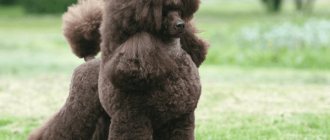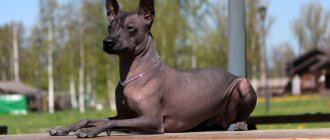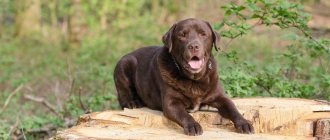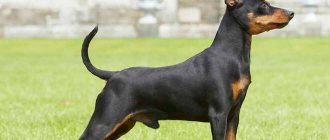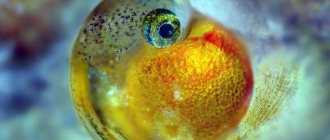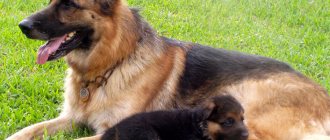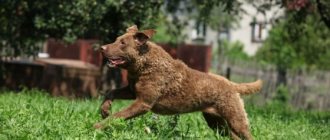Labradors were originally classified as hunting breeds, but now there is virtually no trace left of their former purpose.
These dogs have deservedly taken their place next to humans in their daily lives.
Easy care and easy-going nature made them an excellent companion, as well as a real “family” dog.
This is natural, because Labradors are very friendly, sociable and get along well with children.
What does an adult Labrador look like in the photo?
Labradors have a very proportional and harmonious physique.
They have developed muscles, which once again shows how much these dogs love active recreation.
Description of appearance:
- Wide and large head. Even in puppies it looks a little larger than the rest of the body.
- Labradors have a large and slightly elongated body. The chest is also wide, but has power. The neck is strong and strong. The body is muscular and the loin is short.
- This breed has floppy ears that are positioned slightly behind the head. The eyes are large, almond-shaped, and widely spaced. They have a dark color. The muzzle has an elongated shape.
- The limbs are long and proportional. The paws acquire a rounded shape and are neat. Small membranes of leather can be seen between the fingers.
- The tail, in comparison, bears some resemblance to the tail of an otter: at the base it is thick and powerful, and towards the end it tapers noticeably. Located horizontally to the body, slightly crescent-shaped.
- Labradors have a short, coarse coat. There is a dense undercoat, which is very evident in this breed. This “coat” structure allows dogs to withstand low temperatures. Wool also has water-repellent properties.
Labradors are often confused with golden retrievers.
They look similar in appearance, especially if both are fawn in color. But retrievers have a more chiseled profile and an elegant body structure, as they are focused on smaller game in the hunt.
Advantages and disadvantages
pros:
- love children, adore members of the household, are loyal to the owner, not aggressive;
- are smart, have a developed mind;
- excellent sense of smell;
- suitable for search work;
- easy to learn with the right approach;
- excellent hunters;
- are not afraid of water and heights;
- unpretentious;
- is an excellent guide and companion for older people.
Minuses:
The Labrador sheds actively, especially in the off-season, since the dog is large and has a lot of hair. A Labrador can ruin furniture, chew wires, eat something from the trash, or profit from gifts from the owner’s table. You should only walk your dog on a leash if the walk is planned in public places.
Being affectionate towards strangers can frighten other people and their children. If you are a busy person, then it is better to get a different breed; the animal will not forgive you for a long absence. He will be mischievous and may get sick.
Breed standard
standard was adopted in 1987 :
- General impression. The build is strong, large skull, wide chest and ribs;
- Behavior and temperament. An active dog with a friendly character. Very mobile. Loves water, quickly adapts to any environment, devoted companion. Not cowardly, does not show aggression;
- Head. Wide and massive skull. Pronounced transition from forehead to muzzle. The muzzle itself is not pointed;
- Front part. Dark nose, wide nostrils. Medium sized teeth, scissor bite. The upper jaw tightly covers the lower jaw. Large dark eyes. From a young age, intelligence and friendliness can be read in them. The ears are medium-sized, hanging, close to the head;
- The neck is strong and powerful;
- The forelimbs are straight and parallel;
- Frame. The chest is wide and deep. Back with a horizontal topline. The loin is short and strong.
- The hind legs are straight. The croup is straight and does not slope towards the tail;
- Paws are round, arched;
- The tail is thick at the base, tapered towards the end, thick. Does not bend behind the back;
- Movements are free and smooth;
- The coat is short, thick and without fringes. Does not allow water to pass through;
- The size for a male is 56-57 cm at the withers, for a female - 54-56 cm.
Positive features
The description of the Labrador Retriever breed fully gives an idea of the “golden” character of the dog. The breed is well suited for large families with children and inexperienced dog breeders . The advantages of the breed include:
- the undiminished cheerfulness of dogs;
- great love and devotion to the owner, all households, including other pets;
- lack of aggressiveness;
- good intelligence and obedience (after appropriate education and training);
- sincerity and ability to adapt to each family member.
Character and temperament
As already mentioned, Labradors are very good-natured dogs that have a calm and balanced temperament.
Their character is such that they are always ready for activity and games of any kind..
- They get used to all family members equally. They love children, but due to their large size and excessive size, it is not advisable to leave dogs alone with them.
- They are friendly towards all other animals, as well as strangers. Therefore, you need to be careful when letting Labradors off the leash.
- They easily find contact with dogs of other breeds and, surprisingly, with cats.
- They have a developed mind and intelligence. Easy to learn and remember commands.
- A hardworking dog that always wants to be useful to humans. They like to help, so they can easily learn to fetch slippers or a newspaper.
- They have a large supply of energy. Ideal for people leading an active lifestyle. Labradors will easily agree to and participate in a long run or other sport.
- They do not tolerate loneliness well, are devoted to their owner, have a high level of empathy and sense the mood of others.
- Their tail is the main indicator of emotions. Joyful Labradors can use this part of the body to knock down all objects in their path. There are often cases when it was damaged from too violent waving.
IMPORTANT!
A Labrador can become an ideal dog only after careful training.
It must be remembered that they can just as easily turn into a real hyperactive monster, destroying a house or apartment.
Advantages and disadvantages
Advantages:
- Beautiful, kind exterior.
- He has high intelligence and is easy to train.
- People-oriented.
- It does not require special care.
Flaws:
- Because of his great love for water, he will not pass by a puddle.
- It has no pronounced protective qualities.
- Can't stand loneliness.
- Loves to chew on everything he sees.
- Snores.
Each breed has its own advantages and disadvantages that need to be taken into account before purchasing an animal. Therefore, the dog breeder’s task is to understand what shortcomings of the pet he can treat favorably. Share with us interesting stories about your pets, what disadvantages and advantages do they have?
Popular types and their descriptions
Among Labradors, the following types are distinguished:
- American . Most suitable for sports and hunting. He is active, cheerful, playful and restless. A good choice for those who are bored sitting at home.
- English . If you are a homebody, then this type will suit your temperament. He is calm, in England he was instilled with poise and restraint.
In appearance, these two representatives are practically no different from each other; their main difference is in temperament and character.
History of the Labrador Retriever breed
Labrador Retriever
Whatever geographic associations you may have, researchers have not found a direct connection between Labradors and the North American peninsula of the same name. The version of the origin of the breed from the island of Newfoundland, located southeast and now part of the youngest Canadian province, is considered historically reliable.
The origin of the name of the breed is explained by different theories. According to one, the original color (exclusively black) resembled the igneous rock found in their homeland - labradorite. Supporters of the other argue that Europeans, who were not particularly versed in the intricacies of toponymy of the New World, considered such a name apt for animals that arrived on ships from the shores of the Labrador Sea. It is likely that an elementary need arose to distinguish between the new breed and the longhaired Newfoundland, well known to British breeders of the 19th century. However, there is an opinion that both breeds appeared in England at about the same time and, as a result of confusion, the “natives” from Labrador were named after the neighboring island and vice versa.
By the way, it is assumed that the ancestor of the shaggy giant Newfoundlands was closely related to the ancestor of the Labradors - St. John's water dog. Explore the origins of Water Dog St. itself. John's is not possible due to the long-standing history, but experts admit that it was the result of crossing a large number of breeds that, together with their owners, ended up in North America since the Great Geographical Discoveries.
The first European explorers of the modern coast of Canada were Portuguese sailors, and it is likely through their efforts that Can Diaguas, Portuguese water dogs, bred in the Middle Ages to make life easier for sailors, appeared here. They served as postal couriers between ships of fishing fleets, delivered messages ashore, pulled out things that were overboard, and even helped drive schools of cod into nets. St. John's dogs also excelled in deep water and were used by Canadians to search for and rescue victims of shipwrecks. A series of short-sighted restrictive laws and prohibitively high taxes on dog owners led to a decline in the number of animals, and then to their extinction. The last representatives of this breed died in the 20th century, but its genes live on in Golden Retrievers, Labradors, Chesapeake Bay Retrievers, and Flat-Coated Retrievers.
Labrador puppy
The first Labradors arrived in Europe on merchant ships. For a long time, strong economic ties were established between Newfoundland and England; here Canadians sold cod caught in the Atlantic. The British, passionate lovers of hunting, immediately paid attention to the agile and easy-to-train sailor companions. In the 19th century, the importation of “small Newfoundland dogs” began. The name of the breed that is accepted today only appeared in the 1870s. At the same time, the influx of overseas “fresh blood” began to dry up, and in 1895 the Quarantine Act was adopted, which prohibited the import of animals without a license and a six-month quarantine. From then on, the breed developed virtually exclusively thanks to internal selection.
The first breeders of Labradors, independently of each other, were two noble families - the Earls of Malmesbury and the Dukes of Buccleuch. Kennels located in Hampshire and Scotland respectively helped popularize the breed among local aristocrats. It turned out that short-haired workers from the island of Newfoundland are ideal companions for hunting birds and small game. In addition to endurance and a gentle disposition, with proper upbringing, they were complemented by amazing skills in finding and apporting prey shot by the owner. The success of Labradors was later facilitated by good exhibition qualities.
For several decades, confusion reigned with the definition of belonging to one or another breed. It happened that even puppies from the same litter were classified in documents as different “branches” of retrievers. However, already in 1903, Labradors were officially recognized by the oldest kennel club in the world, the English Kennel. This caused another surge of interest and led to the creation of several new nurseries. In 1916, the Labrador Retriever Club was formed, an organization that still operates today, caring about maintaining the purity of lines.
During the First World War, Labradors crossed the ocean again. In the USA they quickly gained popularity, and the so-called American type gradually emerged, about which there is still debate among experts.
For a long time, black was considered the only acceptable color for an animal; other puppies were discarded. The fawn Labrador Retriever was first registered in 1899, and the chocolate Labrador Retriever was registered in 1930.
Chocolate Labrador
Fawn Labrador
Main types of colors (photos)
There are 3 most popular and standard-recognized types of colors for Labrador Retrievers:
Black
The black color of this dog should be uniform. This color is considered classic. The eyes of a representative of this shade are hazel or dark. The presence of any other spots on the coat is not allowed, only a snow-white spot on the chest is allowed. This is the most ancient color of all, the fur of such Labradors shimmers in the sun, which is explained by the fact that animals of this shade produce more fat in their fur than others.
Pale yellow
This color was included in the standard relatively recently, only in the last century. There are several variations of the shade: golden, pigmented, beige, solid and red fox. There should be no spots on this color. Labradors have fawn-colored eyes and a black nose.
Chocolate
This variation can exist in two shades - dark and light. There are several types of chocolate: liver, light and dark chocolate. A white patch on the chest is allowed. There should be no more light pigmentation on the coat; this is a disadvantage and a defect. The eyes of dogs of this color can be yellow or brown, but the darker their shade, the more purebred the individual is considered.
Life expectancy and what diseases are they susceptible to?
The average life expectancy is 10-14 years. It depends on the conditions of keeping and feeding.
But there are some diseases that Labradors are susceptible to :
- wounds on the paws due to irritation on the skin, when biting the skin with teeth;
- allergies to food, sweets and chicken products. The animal can also suffer from household chemicals, powders, and vitamin preparations. Risk of developing otitis media, dermatosis, eye swelling;
- pathology of the skeletal system;
- obesity, associated with overeating and improper feeding, also occurs with hormonal disorders;
- joint subluxation;
- osteochondrosis.
Non-standard colors
There are also colors that are not included in the standard; dogs of these colors cannot participate in exhibitions, but this does not prevent them from becoming a faithful and devoted family pet:
- Fox, or red fox . This is a variety of fawn. Dogs have a rich red color. Unlike other colors, a dog with such fur can still participate in exhibitions.
- Silver. These are gray Labradors with light eyes. The color comes from crossing them with Weimaraners.
- Dudley . This is a weak fawn. Dogs grow up with light irises, pink nose and eye rims. Also a color not recognized by the standard.
- White. Also a weakened fawn, but unlike Dudley, the rest of the pigmentation is dark. Over time, dogs develop a light golden coating on their fur. Some experts allow Labradors with this color to be exhibited.
- Spotted . Defect or breed defect. Speaks of impure blood. Spotted dogs are not allowed to compete or breed.
It is impossible to predict exactly what color a Labrador puppy will turn out to be. This indicator depends on many qualities, including heredity and genetics.
Education and training
Labradors are incredibly active and cheerful creatures; even as adults they love active games. High intelligence and calm character open up wide opportunities for training. It is not recommended to be too harsh. You should be persistent but patient, do not forget about encouragement (both verbal and with treats) and avoid boring, monotonous activities in which the pet inevitably loses interest in the process.
Early socialization is extremely important so that your dog does not experience stress when in contact with the outside world, other people, animals, and also firmly understands acceptable standards of behavior in various life situations. Labrador owners who do not have experience raising large dogs are better off seeking help from professional dog trainers and taking several lessons or completing a full course of training.
Labrador training
Smooth-haired and long-haired
The standard states that Labradors can only have short hair, and long-haired Labradors must be disqualified.
A breed similar to a Labrador, the Golden Retriever, has long hair..
However, many breeders and experts allow long-haired Labradors to participate in exhibitions; moreover, for many years there has been talk of distinguishing this type into a separate breed.
Labrador wool has the following characteristics::
- Smooth-haired - have a dense and dense undercoat, hard axial hair. She does not form fuzz and does not need frequent bathing or combing. When shedding, its amount decreases significantly and only the undercoat remains.
- Longhaired - have the same undercoat, but their center coat is much longer. It may have feathering in the area of the limbs and tail. It requires more careful care and can become frizzy and frizzy.
The birth of long-haired Labradors means that, at conception, the breeder did not carry out all the genetic examinations to find out whether the recessive gene responsible for such long hair would manifest itself in a given litter.
Care and maintenance
The main commandment of the owner of a Labrador Retriever from the first days should be the principle of moderation in food. The fact is that these dogs are prone to overeating, which leads to obesity and very serious health problems. To avoid troubles, accustom your dog to a strict diet, monitor the volume of portions, do not allow excess “lunch” to remain in the bowl, do not get carried away with dog treats and, of course, do not treat your pet with pieces from the common table - salty, smoked and sweet food . If you prefer natural nutrition, agree on the menu with your doctor and do not forget about vitamin and mineral supplements. When choosing ready-made food, focus on products from trusted brands from the upper price segment. With any type of diet, the dog must have constant access to fresh drinking water.
Food, food, food!
As already mentioned, Labradors are very active; regular physical activity is not just desirable for them, but is a prerequisite for normal well-being and psychological state. Get ready for long walks - experienced breeders advise spending half an hour on them in the morning and at least two hours in the evening. In this case, the dog will not get bored, gain excess weight and pester you with pranks in the apartment.
Caring for a Labrador does not require extra effort. Basically we are talking about standard procedures:
- brushing - daily during the period of active shedding, which occurs twice a year, and once or twice a week the rest of the time, it is recommended to use a special hard brush;
- washing - under normal conditions it is enough to do this once every two months, using products recommended by the veterinarian. Frequent water procedures negatively affect the condition of the coat and skin, as well as immunity;
- brushing teeth regularly, with a special toothpaste for dogs;
- Ear care – to avoid infections, it is necessary to systematically examine the ears and remove dirt with a cotton swab.
It is important, of course, to closely monitor your pet and not postpone a visit to the veterinarian if signs of poor health or atypical behavior are noticed.
What do boys and girls look like and how are they different?
Obviously, the first time you can easily distinguish an adult male Labrador from a female.
Girls are physically smaller than boys. They are lower and differ from them in weight.
Moreover, their exterior is also different:
- They look more graceful, boys stand up looking more courageous and muscular;
- If the bitch has given birth, then it takes on a different outline in terms of the abdomen, more blurred. This is one of the reasons why male dogs win awards at shows, because they manage to maintain ideal physical shape.
There are also differences in temperament.
Big girls become attached to their owner, for them the risk of aggression is completely excluded. They are obedient and affectionate; during a walk, most likely, you will not have to constantly strain to keep them on a leash, because females do not need to explore the territory.
The problem can occur when bitches go into heat..
During this period, you should only walk them on a leash. Girls are also more attentive to children and other family members, they also like to be active, but they are more understanding and it will not be a burden for them to spend a day or two within the walls of the apartment.
During a walk, Labrador boys behave completely differently. They strive to explore the entire territory as fully as possible, mark it, and get to know everything around them, especially if they are animals.
Males are also a little more difficult to train.
If you see a Labrador barking and getting off the leash during a walk, then be sure that it is a boy..
They are more active and restless, and they can remain this way at home if they do not educate them.
Once you put in a little effort, you will see how obedient and reasonable a representative of this breed can become, not only within the walls of an apartment, but also on the street.
At first, both girls and boys can be troublesome, regardless of which gender you choose . The main thing is to start training in time and then you simply won’t notice any shortcomings in this breed.
Labrador Health and Diseases
In general, Labrador retrievers can be called fairly healthy dogs, although any purebred animals, due to the limited choice of lines, have a predisposition to certain genetic diseases.
From birth or with age, some individuals may develop autoimmune diseases or deafness. But in most cases, until old age, visits to the clinic will be sporadic. Puppies must undergo routine vaccinations if this has not been done by the breeder. With proper care and proper nutrition, the average life expectancy of this breed is 10-12 years. Like other large dogs, the Achilles heel of Labradors is the musculoskeletal system; veterinarians call the most common disease hip dysplasia. Cases of cataracts, retinal atrophy and corneal dystrophy are common.
But the main source of danger to a dog’s health is obesity due to an insatiable appetite, which was already mentioned above. This factor affects the length and quality of life of the pet, as it inevitably leads to the development of diabetes, eye diseases, and diseases of the musculoskeletal system. A controlled diet and adequate exercise will help your pet stay active and healthy longer.
What puppies look like from a month to a year
- 1 month. The baby's weight is about 4 kg, height - 23 cm, chest circumference - 38 cm, mouth circumference - 9 cm, head circumference - 28 cm, muzzle length - 4 cm. This is still a funny baby, but he is beginning to develop a need for socialization.
- 2 month. Weight – 8 kg, height – 32 cm, chest circumference – 45-56 cm, muzzle circumference – 22 cm, mouth circumference – 11 cm, head circumference – 31 cm, muzzle length – 5.5 cm. This is a period of fear, so It is worth protecting the puppy from various frightening objects.
- 3 month. Weight – 14 kg, height – 42 cm, chest girth – 51-56 cm, muzzle girth – 24 cm, mouth girth – 11 cm, head girth – 35 cm, muzzle length – 7 cm. Your puppy is still undergoing a period of socialization, already It's time to start training and education.
- 4 month. Weight - 19 kg, height - 45 cm, chest girth - 60 cm, muzzle girth - 25 cm, mouth girth - 12 cm, head girth - 37 cm, muzzle length - 8 cm. The dog is beginning its adolescence. Show more firmness and patience in raising him.
- 5 month. Weight – 22 kg, height – 50 cm, chest circumference – 67 cm, muzzle circumference – 26 cm, mouth circumference – 12 cm, head circumference – 42 cm, muzzle length – 8.5 cm. The puppy is trying to dominate in its relationship with you, become in charge, suppress it.
- 6 month. Weight - 25 kg, height - 55 cm, chest girth - 70 cm, muzzle girth - 28 cm, mouth girth - 12.5 cm, head girth - 43 cm, muzzle length - 9 cm. The puppy continues to grow up, begins to resemble more and more an adult dog.
From the age of six months, all growth indicators of the puppy slow down noticeably.
His main growing up now is intellectual. Up to a year, the look will gradually change - it will become more meaningful, the build will become more muscular, and the behavior will become calm.
Character development with age
- The Labrador puppy is very simple-minded and sincere. He likes to run and play pranks, and can chew things. Proper upbringing and training make it possible to ensure that your pet will not misbehave. The desire to chew things is not a sign of bad character , the baby is hyperactive and needs to pour out his energy somewhere. Buy him toys, he will direct his activity towards them. At the age of 3-4 months (the period of socialization), the little Labrador masters the general course of education.
- During the transition from puppy to adult, the Labrador becomes somewhat calmer. This period is considered to be adolescence and lasts up to 3 years. Before committing an act, the pet comprehends it. At this time, socialization and training of the dog is of great importance.
- In old age, the Labrador's behavior changes somewhat . He still loves everyone around him and is friends with them. But due to deterioration in physical and mental well-being, various changes in behavior are possible. Labrador retrievers become less energetic as they age and require less activity. Older dogs sometimes develop separation anxiety, especially if there is no one in the house during the day (the family is working). If there are family members nearby, such fear does not arise. Due to age, hearing, vision or smell may deteriorate. Your Labrador may develop noise sensitivity and may experience stress due to changes in his home environment. With all changes in the health and psyche of your pet, you need to contact a specialist in a timely manner.
How to choose?
Choose a well-groomed puppy with clean mucous membranes and fur; he should be moderately well-fed, not aggressive and timid, but inquisitive. Keep in mind that boys should be slightly larger than girls even at two months of age.
NOTE!
When walking and running, the dog should not experience lameness, and its paws should be placed straight, without any dislocations.
Try to play with the puppy and pay attention to his activity: avoid lethargic dogs that tend to quickly move away and lie down, most likely there is something wrong with their health.
Observe your puppy's appetite . He should eat well and there should be no parasites in his stool.
Look at the parents of your future pet and their behavior. This way you can draw a conclusion about what the puppy will become in the future.
How much does a Labrador Retriever cost?
The most affordable offers are “hand-off” puppies, without documents and pedigree, but we remind you once again: this way you risk becoming the owner of a dog with poor health or completely devoid of the “trademark” qualities of a Labrador due to the admixture of unknown genes.
A child with papers who cannot count on participation in exhibitions due to more or less significant defects in appearance will cost from 20 to 35 thousand rubles. Of course, this moment does not matter if you just dream of an affectionate and devoted friend for the whole family.
Dogs of the so-called show class, whose parents are recognized champions, and whose characteristics exactly correspond to the breed standard, are much more expensive - in the range of 40-60 thousand rubles. In this case, you will be able to present your pet to a strict court of experts and hope for prizes.
Popular nicknames
When choosing a name, consider the character of your puppy; Labradors are playful and have a loud bark. The name should be euphonious so that both you and your pet feel comfortable.
The nickname
should not be similar to the standard commands “Fu”, “Give”, “Come”, otherwise the dog will confuse them .
Those who adore active and energetic games, such names as: Wind, Henry, Hunter, Zeus, Lord, Spark, Biddy, Yakhont, Nitro, Pilot, etc. will suit them;
Labrador girls are also very smart, have a cheerful, good-natured character, love children and are happy to communicate with people . You can give them names: Star, Arrow, Aima, Vanilla, Jasin, Spark, Laska, Charmy, Yuna, Florence, Maya.

